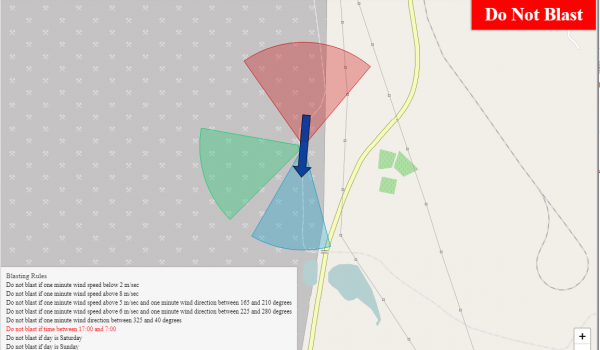The Blast Permissions Tool uses real time high frequency site meteorological data combined with a set of site specific user defined rules to inform mine site staff of the suitability of the current meteorology for blasting operations
- The Benchmark Monitoring Blasting Permissions tool allows input of a simple set of rules used to automatically generate a permission status
- The status is clearly displayed as “Ok To Blast” or “Do Not Blast”
- Rules are "Do not blast" conditions that can include time, time base of met data, wind speed, wind direction, RH, rainfall and barometric conditions
- Each rule can include multiple conditions for example "Do not blast if one minute wind speed above 8 m/sec and one minute wind direction between 370 and 25 degrees"
- Rules are defined by site staff to align with site Blast management plans
- The incoming meteorological data stream is continuously assessed against the user defined rules to inform update of the status. If a 'do not blast status' is obtained the rule that was breached will be highlighted so the user can see at a glance the reason for the status
- The latest meteorological results are displayed clearly on the user interface and the wind direction illustrated by an arrow
- Rapid update of data is achieved by employing private 4G connection for data import to the Benchmark Monitoring cloud server which hosts the blast permission service
- Display can be overlaid on a tile based mapping system generated from high resolution satellite photos of the working lease area
- The “dynamic blasting zone” feature enables drill and blast teams to set the location of the blast and draw a polygon between areas they wish to protect under certain meteorological conditions. Automatic calculation of the angles would inform the rules and affect the resulting “ok to blast” or “do not blast” display
- Developed for managing both mine blasting and haul truck dumping management the tool can be tailored to site requirements

